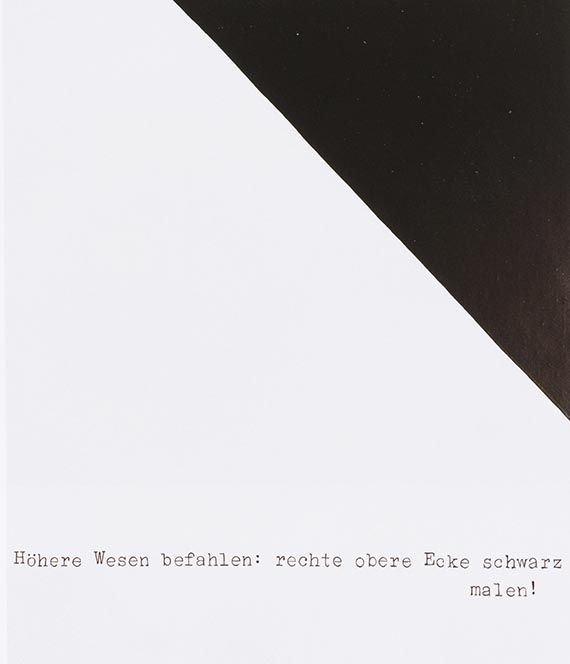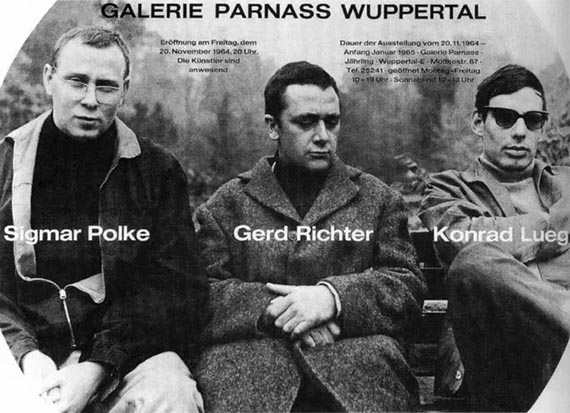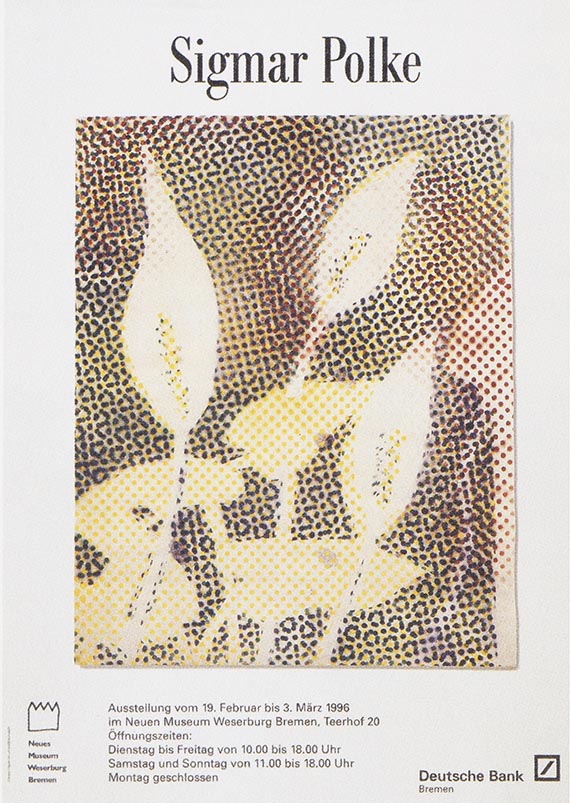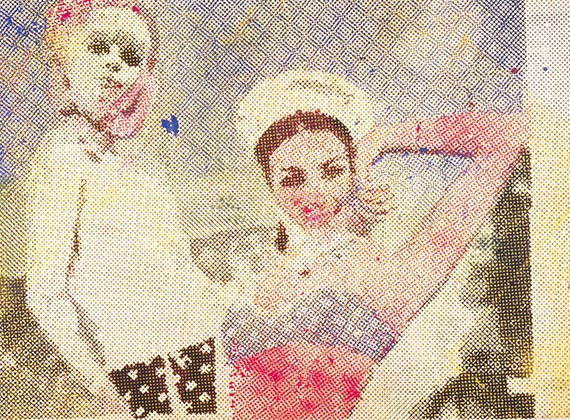Frame image
Frame image
Frame image
Frame image
48
Sigmar Polke
Kallablüten (3-teilig), 1965.
Acrylic and spray paint on paper
Estimate:
€ 400,000 - 600,000
$ 452,000 - 678,000
Kallablüten (3-teilig). 1965.
Acrylic and spray paint on paper.
Each ca. 63.5 x 53.5 cm (25 x 21 in).
One of the present sheets (I) served as a template for the poster of the exhibition “Sigmar Polke” at the Neues Museum Weserburg, Bremen, 1996.
• Early “signature piece”: the painted dot grid becomes Sigmar Polke's artistic trademark.
• “New Realism” and “German Pop”: From Polke's early days with Gerhard Richter in Düsseldorf, today considered the most sought-after period in his oeuvre.
• Polke's “Kallablüte” and Warhol's “Flowers”: In the mid-1960s, both artists used a printed photographic template for a serially produced flower motif that was innovative in both technique and style.
• One of the sheets was part of the exhibition “Sigmar Polke. Works on Paper 1963–1974” at the Museum of Modern Art, New York, in 1999.
• Excellent provenance: From Galerie Fred Jahn, Munich, and the Deutsche Bank Collection.
• Most of Polke's dot grid paintings from the 1960s are part of international collections and rarely appear on the auction market.
• In 2019, the similar painting “Alpenveilchen” (1967) fetched one of the artist's highest international auction prices.
• In 2014/15, the Museum of Modern Art, New York, and the Tate Modern, London, honored Polke's pioneering oeuvre with a spectacular retrospective.
We would like to thank Michael Trier for his scientific advice.
PROVENANCE: Galerie Fred Jahn, Munich.
Deutsche Bank Collection (acquired from the above).
EXHIBITION: One of the present sheets (I) served as a template for the poster of the exhibition “Sigmar Polke” at the Neues Museum Weserburg, Bremen, 1996
Sigmar Polke. Neues Museum Weserburg, Bremen, February 18 - March 3, 1996 (sheet I was selected for the exhibition poster, Becker/von der Osten p. 409).
Sigmar Polke. works on paper 1963-1974, Museum of Modern Art, New York, 1999, cat no. 124 (illustrated on p. 116, sheet II).
"We cannot just wait around for good pictures to be painted one day; we have to take action ourselves! "
Sigmar Polke and Gerhard Richter, 1966
"I love all dots. [..] I am married to many dots. I want all dots to be happy; dots are my brothers. I am a dot, too. "
Sigmar Polke and Gerhard Richter, 1966
Called up: June 6, 2025 - ca. 19.00 h +/- 20 min.
Acrylic and spray paint on paper.
Each ca. 63.5 x 53.5 cm (25 x 21 in).
One of the present sheets (I) served as a template for the poster of the exhibition “Sigmar Polke” at the Neues Museum Weserburg, Bremen, 1996.
• Early “signature piece”: the painted dot grid becomes Sigmar Polke's artistic trademark.
• “New Realism” and “German Pop”: From Polke's early days with Gerhard Richter in Düsseldorf, today considered the most sought-after period in his oeuvre.
• Polke's “Kallablüte” and Warhol's “Flowers”: In the mid-1960s, both artists used a printed photographic template for a serially produced flower motif that was innovative in both technique and style.
• One of the sheets was part of the exhibition “Sigmar Polke. Works on Paper 1963–1974” at the Museum of Modern Art, New York, in 1999.
• Excellent provenance: From Galerie Fred Jahn, Munich, and the Deutsche Bank Collection.
• Most of Polke's dot grid paintings from the 1960s are part of international collections and rarely appear on the auction market.
• In 2019, the similar painting “Alpenveilchen” (1967) fetched one of the artist's highest international auction prices.
• In 2014/15, the Museum of Modern Art, New York, and the Tate Modern, London, honored Polke's pioneering oeuvre with a spectacular retrospective.
We would like to thank Michael Trier for his scientific advice.
PROVENANCE: Galerie Fred Jahn, Munich.
Deutsche Bank Collection (acquired from the above).
EXHIBITION: One of the present sheets (I) served as a template for the poster of the exhibition “Sigmar Polke” at the Neues Museum Weserburg, Bremen, 1996
Sigmar Polke. Neues Museum Weserburg, Bremen, February 18 - March 3, 1996 (sheet I was selected for the exhibition poster, Becker/von der Osten p. 409).
Sigmar Polke. works on paper 1963-1974, Museum of Modern Art, New York, 1999, cat no. 124 (illustrated on p. 116, sheet II).
"We cannot just wait around for good pictures to be painted one day; we have to take action ourselves! "
Sigmar Polke and Gerhard Richter, 1966
"I love all dots. [..] I am married to many dots. I want all dots to be happy; dots are my brothers. I am a dot, too. "
Sigmar Polke and Gerhard Richter, 1966
Called up: June 6, 2025 - ca. 19.00 h +/- 20 min.
Sigmar Polke – genius by accident
A genius by accident is the most apt description of Sigmar Polke and his innovative artistic creations. The remarkable energy and vitality that Polke's works emanate to this day reflect a nonconformist character that viewed traditions and conventions not as guidelines but as obstacles that were to be overcome with ease. With his painting “Höhere Wesen befahlen: obere rechte Ecke schwarz malen!” (Higher beings commanded: paint the upper right corner black!), an icon of German post-war art, Polke earned himself the highly coveted status of a revolutionary anti-artist. With wit and irony, Polke pokes fun at the traditional art world and the general idea of the artist as a genius inspired by divine forces. Polke's art radically broke with the traditions of art history, but at the same time, it has become an essential part of art history today, 15 years after Polke's death. The Polke retrospective at the Museum of Modern Art in New York and the Tate Modern in London in 2014/15 made Polke's outstanding position in postwar European art clear. In addition to New York and London, the critical exhibition was also on view at the Museum Ludwig in Cologne, where it brought together everything that has made Polke's work so incomparable and fascinating for over half a century.

Dot by dot – Polke's iconic grid paintings and the art of the “New Realists”
First and foremost, there are the magnificent grid paintings of the 1960s, such as the famous painting “Freundinnen” (Girlfriends, 1965, Froehlich Collection, Stuttgart), in which Polke, in keeping with the spirit of Pop Art, uses the grid printing technique of newspapers and magazines for his artistic language. Only 24 years old, Polke meticulously applied dots onto the canvas, dot by dot, with great patience, as in our series “Kallablüten”, of which one sheet was on display at the Museum of Modern Art, New York, in 1999, creating a completely new visual aesthetic of iridescent color gradients. Like Gerhard Richter's early black-and-white photo paintings, these fascinating works by Polke are a visual expression of the countercultural spirit of the 1960s. Our series “Kallablüten” is also an important example of this early creative phase, today considered the most sought-after in the artist's extremely diverse oeuvre. During these years, Polke and Richter, both students at the Düsseldorf Art Academy under Karl Otto Götz, worked in close collaboration and shook up the art world of the time with their representational, photo-based art. The young artists broke radically with the established gestural painting of European Informalism, painting figuratively and with almost no visible brushstrokes.

Similar to Andy Warhol's “Flowers,” which the American pop artist created beginning in 1964, a photographic template from mass media may also have been fundamental to Polke's “Kallablüten,” from around the same time. Polke also uses the supposedly trivial flower motif, which also contains references to the popular flower painting of the pre-war period, widespread in the 1960s in reproductions found in many middle-class living rooms in Germany, to establish his completely new figurative and serial approach. In ''Kallablüten'', Polke overcomes the traditional genre of the flower still life and reinvents its aesthetic principles. The artist frequently drew inspiration from print and classified ads for his works. As in the present case, the exact source is often impossible to identify—unlike Richter, who documented all his image sources in his 'Atlas.' Polke constructs the artwork from individual dots, thus making the process of the picture's creation transparent. Just as the newspaper photo plays with the illusion of reality, Polke's grid images play with the illusion of newspaper print, which, upon closer inspection, proves to be unique and, thus, pure deception. Each dot is different in execution and color composition, giving it its distinctive character. To this day, it is fascinating to experience this dot character in front of Polke's originals and to try to fathom the unique rhythm their sequence creates. Shortly before making the “Kallablüten,” Sigmar Polke and Gerhard Richter staged the legendary exhibition “Neue Realisten” (New Realists) at Galerie Parnass in Wuppertal, a title that, alongside “German Pop” and the ironic self-designation “Capitalist Realism,” would henceforth be used to classify this young art movement. The non-conformist, youthful spirit characterizes Polke's rare grid paintings of the 1960s and his love of dots, which would become his trademark.

Sigmar Polke – master of the dot and free association
Polke revisited the technical innovation of the grid dot in the 1980s and 1990s for his famous fabric paintings, in which the grid dots were often incorporated as unrecognizable enlarged fragments or quotations. They remained references to his revolutionary early work but also, of course, to the work of Pop Art artists Roy Lichtenstein, Richard Hamilton, and Andy Warhol, whose work was also fundamentally influenced by the artistic exploration of Benday dots, which are required for the reproduction of templates in offset printing. In an additive process, the fabric pictures merge a highly enlarged system of grid dots, the pattern of the fabric, and representational and gestural elements into an associative whole, thus utilizing a process developed from the free combination of a wide variety of elements. This process is reminiscent of Robert Rauschenberg's silkscreen paintings, which the American artist developed from his early “Combines.” Polke, too, repeatedly presents observers of his dense creations with an engaging yet potentially unsolvable puzzle. From the outset, Polke's entertaining and tongue-in-cheek oeuvre has been characterized by his skillful blending of diverse references and allusions to form an associative whole. Polke would have turned 80 in 2021, and the art magazine Monopol celebrated him on this anniversary with the following words: “Sigmar Polke's laughter echoes. It comes from a delightfully silly reverence, from an artist liberated from all constraints – and one whose seminal influence lives on to this day.” [JS]

A genius by accident is the most apt description of Sigmar Polke and his innovative artistic creations. The remarkable energy and vitality that Polke's works emanate to this day reflect a nonconformist character that viewed traditions and conventions not as guidelines but as obstacles that were to be overcome with ease. With his painting “Höhere Wesen befahlen: obere rechte Ecke schwarz malen!” (Higher beings commanded: paint the upper right corner black!), an icon of German post-war art, Polke earned himself the highly coveted status of a revolutionary anti-artist. With wit and irony, Polke pokes fun at the traditional art world and the general idea of the artist as a genius inspired by divine forces. Polke's art radically broke with the traditions of art history, but at the same time, it has become an essential part of art history today, 15 years after Polke's death. The Polke retrospective at the Museum of Modern Art in New York and the Tate Modern in London in 2014/15 made Polke's outstanding position in postwar European art clear. In addition to New York and London, the critical exhibition was also on view at the Museum Ludwig in Cologne, where it brought together everything that has made Polke's work so incomparable and fascinating for over half a century.

Sigmar Polke, Höhere Wesen befahlen: rechte obere Ecke schwarz malen!, 1969, lacquer on canvas, Froehlich Collection, Stuttgart. © The Estate of Sigmar Polke, Cologne / VG Bild-Kunst, Bonn 2025
Dot by dot – Polke's iconic grid paintings and the art of the “New Realists”
First and foremost, there are the magnificent grid paintings of the 1960s, such as the famous painting “Freundinnen” (Girlfriends, 1965, Froehlich Collection, Stuttgart), in which Polke, in keeping with the spirit of Pop Art, uses the grid printing technique of newspapers and magazines for his artistic language. Only 24 years old, Polke meticulously applied dots onto the canvas, dot by dot, with great patience, as in our series “Kallablüten”, of which one sheet was on display at the Museum of Modern Art, New York, in 1999, creating a completely new visual aesthetic of iridescent color gradients. Like Gerhard Richter's early black-and-white photo paintings, these fascinating works by Polke are a visual expression of the countercultural spirit of the 1960s. Our series “Kallablüten” is also an important example of this early creative phase, today considered the most sought-after in the artist's extremely diverse oeuvre. During these years, Polke and Richter, both students at the Düsseldorf Art Academy under Karl Otto Götz, worked in close collaboration and shook up the art world of the time with their representational, photo-based art. The young artists broke radically with the established gestural painting of European Informalism, painting figuratively and with almost no visible brushstrokes.

Exhibition poster: New Realists, Sigmar Polke, Gerhard Richter, Konrad Lueg, Galerie Parnass, Wuppertal, November-December 1964. © Gerhard Richter 2025 (06052025) / The Estate of Sigmar Polke, Cologne / VG Bild-Kunst, Bonn 2025
Similar to Andy Warhol's “Flowers,” which the American pop artist created beginning in 1964, a photographic template from mass media may also have been fundamental to Polke's “Kallablüten,” from around the same time. Polke also uses the supposedly trivial flower motif, which also contains references to the popular flower painting of the pre-war period, widespread in the 1960s in reproductions found in many middle-class living rooms in Germany, to establish his completely new figurative and serial approach. In ''Kallablüten'', Polke overcomes the traditional genre of the flower still life and reinvents its aesthetic principles. The artist frequently drew inspiration from print and classified ads for his works. As in the present case, the exact source is often impossible to identify—unlike Richter, who documented all his image sources in his 'Atlas.' Polke constructs the artwork from individual dots, thus making the process of the picture's creation transparent. Just as the newspaper photo plays with the illusion of reality, Polke's grid images play with the illusion of newspaper print, which, upon closer inspection, proves to be unique and, thus, pure deception. Each dot is different in execution and color composition, giving it its distinctive character. To this day, it is fascinating to experience this dot character in front of Polke's originals and to try to fathom the unique rhythm their sequence creates. Shortly before making the “Kallablüten,” Sigmar Polke and Gerhard Richter staged the legendary exhibition “Neue Realisten” (New Realists) at Galerie Parnass in Wuppertal, a title that, alongside “German Pop” and the ironic self-designation “Capitalist Realism,” would henceforth be used to classify this young art movement. The non-conformist, youthful spirit characterizes Polke's rare grid paintings of the 1960s and his love of dots, which would become his trademark.

Exhibition poster: Sigmar Polke, Neues Museum Weserburg, Bremen 1996 (with one of the works on offer).
© The Estate of Sigmar Polke, Cologne / VG Bild-Kunst, Bonn 2025
© The Estate of Sigmar Polke, Cologne / VG Bild-Kunst, Bonn 2025
Sigmar Polke – master of the dot and free association
Polke revisited the technical innovation of the grid dot in the 1980s and 1990s for his famous fabric paintings, in which the grid dots were often incorporated as unrecognizable enlarged fragments or quotations. They remained references to his revolutionary early work but also, of course, to the work of Pop Art artists Roy Lichtenstein, Richard Hamilton, and Andy Warhol, whose work was also fundamentally influenced by the artistic exploration of Benday dots, which are required for the reproduction of templates in offset printing. In an additive process, the fabric pictures merge a highly enlarged system of grid dots, the pattern of the fabric, and representational and gestural elements into an associative whole, thus utilizing a process developed from the free combination of a wide variety of elements. This process is reminiscent of Robert Rauschenberg's silkscreen paintings, which the American artist developed from his early “Combines.” Polke, too, repeatedly presents observers of his dense creations with an engaging yet potentially unsolvable puzzle. From the outset, Polke's entertaining and tongue-in-cheek oeuvre has been characterized by his skillful blending of diverse references and allusions to form an associative whole. Polke would have turned 80 in 2021, and the art magazine Monopol celebrated him on this anniversary with the following words: “Sigmar Polke's laughter echoes. It comes from a delightfully silly reverence, from an artist liberated from all constraints – and one whose seminal influence lives on to this day.” [JS]

Sigmar Polke, Freundinnen, 1965, dispersion on canvas, Froehlich Collection, Stuttgart. © The Estate of Sigmar Polke, Cologne / VG Bild-Kunst, Bonn 2025
48
Sigmar Polke
Kallablüten (3-teilig), 1965.
Acrylic and spray paint on paper
Estimate:
€ 400,000 - 600,000
$ 452,000 - 678,000
Buyer's premium, taxation and resale right compensation for Sigmar Polke "Kallablüten (3-teilig)"
This lot can only be purchased subject to regular taxation, artist‘s resale right compensation is due.
Regular taxation:
Hammer price up to 800,000 €: herefrom 27 % premium.
The share of the hammer price exceeding 800,000 € is subject to a premium of 21% and is added to the premium of the share of the hammer price up to 800,000 €.
The share of the hammer price exceeding 4,000,000 € is subject to a premium of 15% and is added to the premium of the share of the hammer price up to 4,000,000 €.
The statutory VAT of currently 7 % is levied to the sum of hammer price and premium.
Calculation of artist‘s resale right compensation:
For works by living artists, or by artists who died less than 70 years ago, a artist‘s resale right compensation is levied in accordance with Section 26 UrhG:
4 % of hammer price from 400.00 euros up to 50,000 euros,
another 3 % of the hammer price from 50,000.01 to 200,000 euros,
another 1 % for the part of the sales proceeds from 200,000.01 to 350,000 euros,
another 0.5 % for the part of the sale proceeds from 350,000.01 to 500,000 euros and
another 0.25 % of the hammer price over 500,000 euros.
The maximum total of the resale right fee is EUR 12,500.
The artist‘s resale right compensation is VAT-exempt.
Regular taxation:
Hammer price up to 800,000 €: herefrom 27 % premium.
The share of the hammer price exceeding 800,000 € is subject to a premium of 21% and is added to the premium of the share of the hammer price up to 800,000 €.
The share of the hammer price exceeding 4,000,000 € is subject to a premium of 15% and is added to the premium of the share of the hammer price up to 4,000,000 €.
The statutory VAT of currently 7 % is levied to the sum of hammer price and premium.
Calculation of artist‘s resale right compensation:
For works by living artists, or by artists who died less than 70 years ago, a artist‘s resale right compensation is levied in accordance with Section 26 UrhG:
4 % of hammer price from 400.00 euros up to 50,000 euros,
another 3 % of the hammer price from 50,000.01 to 200,000 euros,
another 1 % for the part of the sales proceeds from 200,000.01 to 350,000 euros,
another 0.5 % for the part of the sale proceeds from 350,000.01 to 500,000 euros and
another 0.25 % of the hammer price over 500,000 euros.
The maximum total of the resale right fee is EUR 12,500.
The artist‘s resale right compensation is VAT-exempt.
Headquarters
Joseph-Wild-Str. 18
81829 Munich
Phone: +49 89 55 244-0
Fax: +49 89 55 244-177
info@kettererkunst.de
Louisa von Saucken / Christoph Calaminus
Holstenwall 5
20355 Hamburg
Phone: +49 40 37 49 61-0
Fax: +49 40 37 49 61-66
infohamburg@kettererkunst.de
Dr. Simone Wiechers / Nane Schlage
Fasanenstr. 70
10719 Berlin
Phone: +49 30 88 67 53-63
Fax: +49 30 88 67 56-43
infoberlin@kettererkunst.de
Cordula Lichtenberg
Gertrudenstraße 24-28
50667 Cologne
Phone: +49 221 510 908-15
infokoeln@kettererkunst.de
Hessen
Rhineland-Palatinate
Miriam Heß
Phone: +49 62 21 58 80-038
Fax: +49 62 21 58 80-595
infoheidelberg@kettererkunst.de
We will inform you in time.




 Lot 48
Lot 48 


